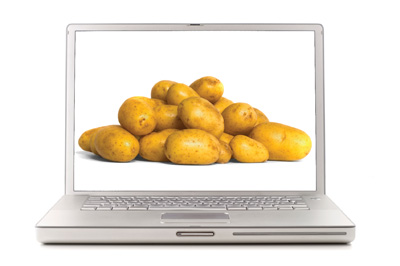
Features
Production
Research
Eye on Potatoes: Technical information can improve potato yields, says Idaho specialist.
Technical information can improve potato yields, says Id
March 13, 2008 By Eye On Potatoes
The goal of every potato grower is to grow the best potatoes for the best economic results, says Bryan Hopkins.
 Technical information can improve potato yields, says Idaho specialist.
Technical information can improve potato yields, says Idaho specialist.
The goal of every potato grower is to grow the best potatoes for the best economic results, says Bryan Hopkins.
And, to that end, the University of Idaho certified soil scientist and potato specialist strongly advises growers to make use of all the information available to them.
“You need good information if you want to stay in business for long and make as much (money) as you should be,” Hopkins says. “I have seen many growers make mistakes – particularly with fertilizer applications – because they didn’t have the right information.”
Hopkins suggests one way growers can improve production is to learn from the past – study yield maps and aerial imagery from previous years.
“You need to work with someone who is committed to the concept and willing to go the extra mile to ensure that the map data is accurate,” he advises. “You probably need someone who is a computer whiz. And it is very important to work the kinks out before harvesting.”
To understand the information the yield maps have to offer, Hopkins suggests converting the yields into relative values so growers can compare one crop to another. He also proposes combining all of the data from the different crop years into cumulative maps (both for multiple and individual crops) for more meaningful comparisons.
“One progressive potato grower was able to triple his yield in some spots,” he says.
Some of the technological tools available to potato producers allow them to concentrate on the spatially consistent variables of production rather than the random ones, Hopkins says. For example, there is little that a potato grower can do about the random damage caused by hail, but he/she can manage the problem spots tied to specific locations in the field, locations where the trouble may be caused by soil conditions, field topography, or the tile drainage.
“Technology allows you to put numbers to the problem and draw lines,” Hopkins says. “It is best to work with an expert who can advise you if the area can be managed or should be left. You might also want to consult an accountant to help you determine how long it would take to recover investment costs.”
In addition to yield maps, another way of observing the spatial variables is through in-season aerial imaging. This technology can be used to detect stressed plants in the field that may look healthy to the naked eye, says Hopkins. Adding near infrared imaging can help detect stress in a crop two to three weeks before it is visible . He admits that in-season aerial imaging is not quite as effective as studying yield maps, but it is less costly and easier to implement.
Bare soil imaging is also helpful in carving out field management zones based on soil colour, texture and water areas, Hopkins says, although growers will need to verify the image information with on-site sampling and inspection. “Bare soil imaging works best in combination with other sources of information, such as topography maps and soil surveys. Grower knowledge of field history also plays a major role.”
Hopkins conducted research with five growers who used bare soil imagery to determine what areas in their fields needed more nitrogen, resulting in a more than $200 per acre improvement in net returns.
Another new technology growers may want to keep on their radar is the use of optical sensors on sprayers to determine the health and needs of individual plants. “It’s almost like being able to fertilize each plant individually,” Hopkins says. “The sensors can make a phenomenal difference in your yields, but it is still early in its development.”
And one current drawback to the technology is the price – each sensor costs between $2,000 and $3,000, Hopkins says.
Print this page